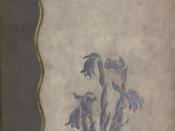Northrop Frye's Anatomy of Criticism illustrates that literature without a narrative can still be classified according to his various modes. By assessing the world of the speaker, you can learn the speaker's situation and assess which mode the speaker is classified in. This is true of Emily Dickinson's poem number 465. Dickinson, although never actively speaking in the poem, describes in a lyric voice her own last link between consciousness and death. Using metaphor and wording in which the meaning can be inferred in various ways, she allows the reader to interpret the poem in their own way while still having her own specific meaning in mind.
In Dickinson's poem the speaker, whom Frye would call the "hero," is trying to travel from the low mimetic to the mythic mode. Mythic mode, the high mode, involves gods and grand conflicts. The speaker of the story is lying awaiting death.
Dickinson writes of "the last onset- when the King- be witness in the room." King, capitalized in this way, could be meant to mean God. This speaker is waiting to leave the low mimetic mode- a world where there is nothing left of her but the possessions she is leaving behind. "I willed my keepsakes- signed away what portion of me be assignable" (Dickinson, 2516). She is waiting for the appearance of the King, and the entrance into the high mimetic mode, but the fly, the mundane being, is preventing her ascent into the world of grand salvation.
The story's speaker remains a low mimetic hero. The low mimetic mode focuses on individual salvation. The low mimetic hero does not have divine intervention at their disposal. They must come to their own epiphanies. Because the conflict of the story is based on the speaker attempting to access the divine...


